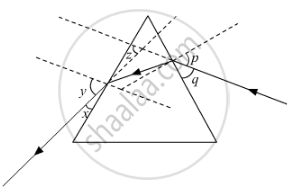Advertisements
Advertisements
प्रश्न
Why do the component colours of incident white light split into a spectrum while passing through a glass prism, explain
उत्तर

The splitting of a beam of white light into its seven constituent colours, when it passes through a glass prism, is called the dispersion of light.
When a beam of white light enters a prism, it gets refracted and splits into its seven constituent colours, viz. violet, indigo, blue, green, yellow, orange, and red. This splitting of the light ray occurs because of the different angles of bending for each colour. Hence, each colour while passing through the prism bends at different angles with respect to the incident beam. This gives rise to the formation of the colour spectrum.
APPEARS IN
संबंधित प्रश्न
Study the following ray diagram:

In this diagram, the angle of incidence, the angle of emergence and the angle of deviation respectively have been represented by
(A) y, p, z
(B) x, q, z
(C) p, y, z
(D) p, z, y
Describe how you could demonstrate that white light is composed of a number of colours.
A beam of white light falls on a glass prism. The colour of light which undergoes the least bending on passing through the glass prism is:
(a) violet
(b) red
(c) green
(d) blue
State two uses of ultraviolet radiation.
Write the range of wavelength of the visible spectrum.
Say TRUE or FALSE
Rainbow is formed by dispersion of which light by water drops
During dispersion of white light by prism placed in air, for a particular value of angle of prism,
dispersive power of crown glass? Given that µv = 1.5230, µr = 1.5145
State the colour which bends:
- The most.
- The least while passing through a glass prism.
